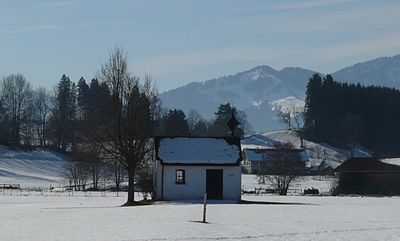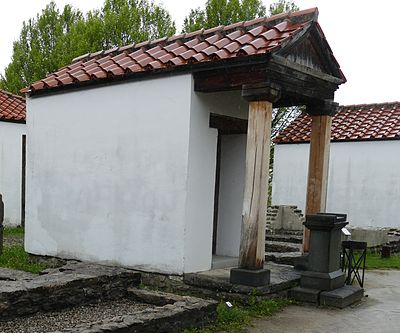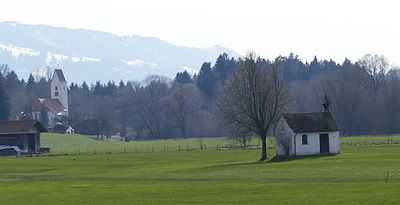Loja chapel
The Loja Chapel is a new chapel from 1956 on the site of medieval and Roman predecessor buildings near Zipfwang in Sulzberg .
It is consecrated to St. Margaret , one of the fourteen helpers in need .
history
The chapel is located on the remains of an ancient building from the 1st to 3rd centuries, which Ohlenroth excavated archaeologically in 1936. According to the excavation report, this building was initially constructed in wood, later built over in stone and equipped with hypocaust underfloor heating. According to Ohlenroth, this building was converted into a temple from the 3rd century onwards. Since the area was part of the Roman Empire until the 5th century, when Christianity was introduced as the state religion from the year 380 , this temple could have been used as an early Christian church. The chapel saint Margaretha of Antioch († around 305) came from Galatia, a formerly Celtic region of the Roman Empire.
A radar survey in 2013 identified the ancient predecessor building as part of the Roman Villa Rustica von Zipfwang , from which several other buildings and a surrounding wall could be detected.
The medieval Loja chapel
In the Middle Ages, a chapel was built exactly above the possible Roman temple, which Ohlenroth was able to examine in 1936. This building was at least two-phase, according to Ohlenroth from the rubble stones of the Roman building , inexactly geosted and with a possible extension made of wood. Finds of high Gothic ceramics and religious pendant medals from the early 17th century date the chapel to at least this period and suggest a role that was perhaps more lively earlier .
According to Ohlenroth, however, it would be premature ... to speak of a seamless connection in tradition between Roman and medieval religious buildings.
Miracle Cross from Ried
According to legend, a Gothic lecture cross was found at the site of the Loja Chapel , the Miracle Cross of Ried . It was kept in the nearby branch church of St. Michael in Ried near Ottacker, which, according to legend, was built specifically for this purpose. A documentation from the church dates the cross made of gold-plated copper parts to the middle of the 14th century, Ohlenroth calls it an excellent late Gothic goldsmith's work. It was stolen and destroyed in 1948.
A photo of the original cross is preserved in a book from 1908.
The name Loja
According to Ohlenroth, the name could come from St. Lei , that would be the popular name of St. Eligius the patron saint of goldsmiths, if he had been the patron saint of the church before St. Margaret. However, this would not explain the final letter 'a' etymologically. That is why he prefers the explanation with pre-Roman river names with the root a-aha (like Ach), due to the location on a small Ach or its confluence with the Iller. He cites Leubas and LOIUM near Rouen as examples . The reference to pre-Roman river names would be common in Roman times and their preservation particularly frequent. The role of the small Ache would be given to the Huber Bach or the Kenelsbach.
literature
- L. Ohlenroth: The Roman settlement at the Loja chapel . In: Allgäu history friend . tape 41 , 1937, ISSN 0178-6199 , DNB 011812389 , p. 51-73 .
- Max Förderreuther: The Allgäu Alps: Country and People . 1908.
Web links
- Roland Linck, Jörg WE Faßbinder , Léa Front, Florian Becker: Ground radar prospection enables reconstruction of the Roman villa at the Loja Chapel in Sulzberg . In: The Archaeological Year in Bavaria . 2013, ISBN 978-3-8062-3008-6 , pp. 103-105 ( online at www.academia.edu [accessed January 25, 2015]).
- The sunken city of Loa and the Miracle Cross in Ried. at: haben.at
Coordinates: 47 ° 38 ′ 43.7 " N , 10 ° 19 ′ 16.6" E



